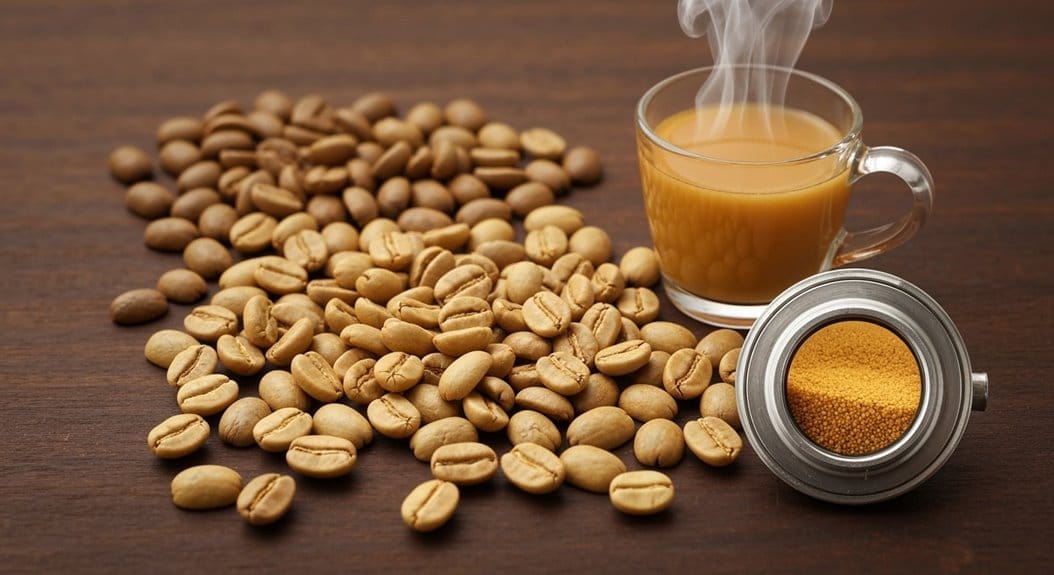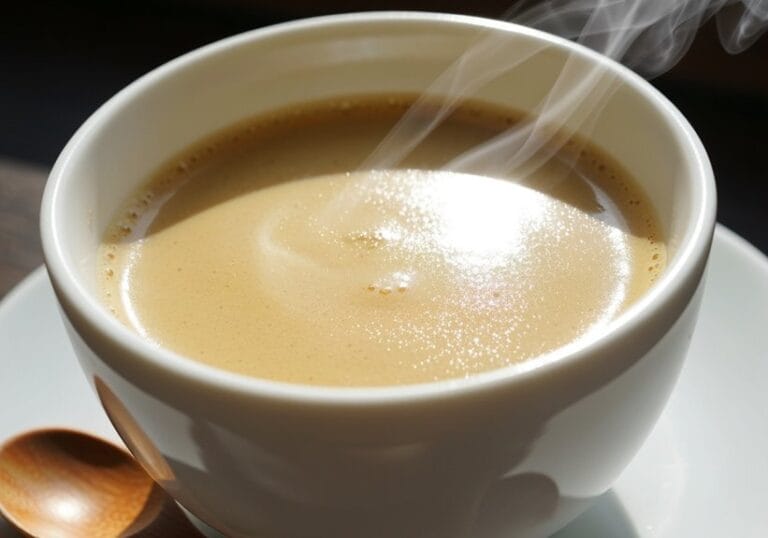Blonde roast coffee is like the cheerful cousin at a family gathering—bright, lively, and a little nutty! It’s a light roast, roasted quickly at lower temps, bringing out fruity, floral notes that taste like sunshine in a cup. Plus, it packs more caffeine than darker roasts—up to 95 mg per cup! Perfect for those who find dark coffee too smoky. If that sounds intriguing, wait till you hear more about the flavorful adventures waiting in that mug!
Key Takeaways
- Blonde roast coffee is a light roast characterized by a golden hue and a dry appearance due to short roasting times.
- It offers a flavor profile with fruity, floral notes, bright citrus, and a touch of sweetness.
- The average caffeine content in blonde roast coffee is about 95 mg per 8-ounce serving, often higher in certain brands.
- It is gaining popularity, especially among younger coffee drinkers, appealing to those who find dark roasts too intense.
- The market for blonde roast coffee is expanding, with brands promoting it through tastings and events to attract curious consumers.
Definition and Roasting Process
In regards to blonde roast coffee, one might think, “What on earth is the deal with this light-colored brew?” Well, let’s unpack that!
Blonde roast coffee is a light roast, you see, roasted for a shorter time and at lower temperatures. This means the beans are pulled out of the roaster just before or right after the initial crack, kind of like rushing to grab cookies from the oven—if you wait too long, disaster strikes!
The color? A lovely golden hue, reminiscent of toasted marshmallows—not that anyone really wants to drink burnt marshmallows! These beans, mostly Arabica, maintain their density and rarely release oils, resulting in a dry appearance. Cue the careful roasting techniques to make certain the beans don’t end up tasting like, well, grass! Interestingly, blonde roast coffee is noted for its higher caffeine content compared to darker roasts, making it a popular choice for those seeking a milder, yet invigorating cup. This light roast typically averages about 95mg of caffeine per 8-ounce cup, surpassing the caffeine found in many dark roasts.
Flavor Profile and Characteristics
Blonde roast coffee brings a whole new level of flavor to the table, and honestly, it’s like a party for your taste buds—you’ve got fruity vibes, floral notes, and a sprinkle of sweetness all plunging together in one cup!
It’s truly a flavor diversity extravaganza, with bright citrus, juicy lemon, and those delightful floral hints of jasmine.
And let’s not forget the sweet whispers of honey and the nutty bursts of hazelnut! The acidity balance is something to marvel at too—higher than darker roasts, it offers a zesty kick that keeps things fresh.
Each sip feels like a joyful dance of flavors, all thanks to those fabulous beans and where they come from. Who knew coffee could be this fancy?
Caffeine Content and Bean Selection

While most coffee drinkers might not think too deeply about caffeine content or the types of beans they’re sipping on, it’s definitely something worth exploring—trust me! Blonde roast coffee often delivers a caffeine punch, averaging 95 mg per 8 ounces, with some Starbucks versions skyrocketing to 475 mg. Amazing, right? The secret lies in bean density; denser beans, often from higher altitudes, retain more caffeine during the lighter roasting process. This also plays into caffeine extraction, as cold brews usually pack more caffeine than iced blonde roasts. Here’s a quick look at the caffeine levels in different servings:
| Serving Size | Caffeine Content (mg) |
|---|---|
| 8 oz Starbucks Blonde | 180 |
| 12 oz Ready-to-Drink | 120 |
| 20 oz Venti Blonde | 475 |
Popularity and Usage
Coffee lovers everywhere are buzzing about the rising trend of Blonde Roast, and let’s be real—it’s not just a passing phase. This vibrant brew is eyeing a potential billion-dollar market, targeting around 54 million curious coffee drinkers. Who knew light roasts could pack such a punch, right?
Typically, they attract folks who think traditional dark roasts taste like they’re sipping from a campfire! With tastings and fun events, brands are pushing Blonde Roast into the spotlight, and it’s gaining traction, especially among younger coffee drinkers.
Sure, it’s still a niche market—around 12–19%—but hey, even hipsters gotta have options! So, whether it’s for the brightness or those fancy flavor notes, Blonde Roast is here to stay!
Frequently Asked Questions
Is Blonde Roast Coffee Suitable for Cold Brewing?
Blonde roast coffee is suitable for cold brewing, offering benefits like a bright flavor profile and a revitalizing finish. Its higher acidity and nuanced flavors translate well, providing a smooth, less intense cold brew experience.
How Does Blonde Roast Compare to Medium Roast?
Blonde roast features a brighter flavor profile with higher acidity and fruitier notes, while medium roast offers a balanced, richer flavor. Furthermore, blonde roast typically contains more caffeine due to its shorter roasting time and lower temperatures.
Can I Use Blonde Roast for Espresso?
Blonde roast can be used for espresso, offering a unique flavor profile with bright, fruity notes. Diverse brewing methods improve its delicate characteristics, providing a smoother, sweeter espresso compared to traditional darker roasts.
What Grind Size Is Best for Blonde Roast Coffee?
The best grind size for blonde roast coffee varies by brew methods, with medium-fine for espresso, medium-coarse for pour-over, and coarse for French press all optimizing the distinct flavor profile of this light roast.
How Should Blonde Roast Coffee Be Stored?
Blonde roast coffee should be stored in airtight storage containers, ideally opaque, to improve flavor preservation. Keeping them in a cool, dry place, away from light and moisture guarantees ideal freshness and quality retention.





